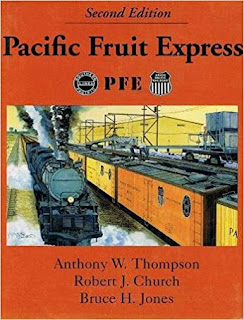 |
| Date (approx.) 1945-1950, Photographer unknown. Courtesy Bob's Photos |
The pedigree of the car to the far right of the photo above has proven remarkably stubborn to uncover (it's shown in a cropped shot below).
I'd love to be able to identify this particular car. At one point thought I had. At this point I'm open to any and all suggestions and thoughts as to what it might be.
Here's what I do know:
- Based on the other cars, and some clues on the locomotives (there are two the road engine and the helper shown above cut in to the train) we know this photo was taken just after WWII (sometime between 1946-1950 or so). The end is certainly a flat plate end on the car in question - with what looks like a roof recessed slightly from the end.
- The reporting marks look like they start with an "L."
- Lettering is clearly serif (ie., "Railroad Roman")
- Car number appears to be 5 digits - first number has a strong vertical element - perhaps a "1", "4", or even a "7".
- I thought at first the reporting marks were "L & N", but couldn't locate any L&N cars that matched the other spotting features shown.

I thought at one point it may be an Louisiana & Arkansas 1932 ARA car, since the ends certainly look like they would be a match to those cars. I was thrilled to learn Atlas even did a factory-decorated L&A 1932 ARA boxcar and was equally thrilled when I managed to locate one for sale at a hobby shop in Wisconsin. The car was shortly winging its way to the Old Dominion. I should have know things were going too well as not much time elapsed before Ted Culotta rained on my parade when he pointed out the car in the photo doesn't have a tabbed side sill like the L&A prototypes. Ted continued "I have this photo, too, and tried my best to determine the provenance of the car, but came up empty looking at my L&A and KCS freight car photos. I am stumped, but I'll keep digging..."
Perhaps the first initial isn't an "L" at all - but Ted and I have both done high-res enlargements of this photo and it certainly looks like an "L" with a space and another single letter.
I fully admit it's some sort of obsessive behavior to be trying to identify an otherwise nondescript boxcar from more than a half century ago. But that's prototype modeling....
Thought I'd throw it out on the table here and see what the collective believes this car might be.
Two questions:
1. Anyone want an Atlas L&A 1932 ARA boxcar? I apparently have one I don't need...












